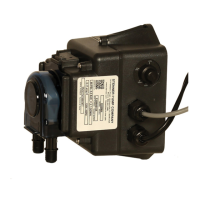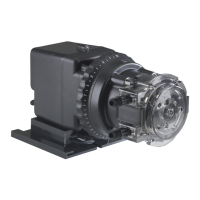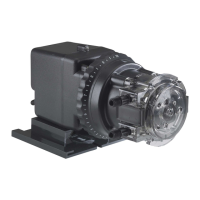Do you have a question about the Stenner Pumps ECON FP Series and is the answer not in the manual?
Explains the limited warranty period, coverage, and exclusions for defective parts.
Outlines the 30-day return policy, RMA process, and restocking fees for factory direct purchases.
Provides instructions for reporting damaged or lost shipments within a specific timeframe.
Details procedures for returning pumps for warranty or repair, including preparation steps.
States the manual's purpose and lists registered trademarks used.
Emphasizes reading instructions, supervising children, and saving instructions for future reference.
Details the risk of electric shock and requirements for GFCI protection and cord integrity.
Explains signal words and details hazards like electric shock, explosion, exposure, fire, and chemical overdose.
Defines CAUTION and NOTICE, and provides guidelines for plumbing and pump usage.
Covers electrical installation, auxiliary safety devices, injection points, and maximum temperature.
Lists materials for housings, pump tubes, fittings, fasteners, and strainer caps.
Lists all items provided in the accessory kit for pump installation and maintenance.
Tables detailing pump flow rates in gallons and liters per day, hour, and minute at max pressure.
Notes on output approximations, pressure limits, and the recommendation for field calibration.
Describes the SECONDS mode, triggered by dry contact signals for timed operation.
Explains the AUXILIARY mode, activated by 12-24VAC/VDC signals for speed-controlled operation.
Details the FLOW SWITCH mode, using dry contact signals for speed-controlled operation.
Instructions for unlocking the keypad, standby mode, and selecting modes/settings.
Explains indicators like PRIME, STANDBY, SIGNAL, PAUSE, and KEYPAD LOCKED.
Visual examples illustrating different states and settings on the control panel display.
Steps for calculating system flow rate and determining dosage and chemical strengths.
Tables listing common chemical strengths and oxidation rates for water treatment calculations.
Formula to calculate the metering pump's required output in gallons per day (GPD).
Chart to confirm selected pump's maximum output exceeds the calculated requirement.
Steps to calculate available dose time and pump operating time in seconds.
Formula and chart to determine and set the pump operating time percentage.
Warning about potential dosing errors if operating time exceeds available dose time.
Detailed steps to program the pump's operating mode and time percentage via the control panel.
Visual examples demonstrating keypad locked and percentage setting on the control panel.
Guidelines for interfacing with the pump via 12-24VAC/VDC signals and determining water volume.
Formulas for calculating chemical feed duration based on flow rate and signal volume.
Warning about reduced feed duration and dosing errors if system flow rate exceeds calculated values.
Formula and steps to calculate and program pump speed percentage via control panel.
Visual examples of control panel states for locked keypad and set speed percentage.
Formula and steps to calculate and program pump speed percentage via control panel.
Visual examples of control panel states for locked keypad and set speed percentage.
General safety instructions including hazards, PPE, and code compliance.
Warnings on product use, tube inspection, and installation location suitability.
Guidance on location, avoiding open tanks, vertical mounting, and verifying receptacle voltage.
Warnings against mounting pump head up, over open tanks, and for outdoor installation requirements.
Instructions for connecting signal wires for different modes, including polarity details.
Steps for capping wires, plugging in power, removing cover, and placing the pump in standby.
Specific installation requirements for CE pumps: location, fixed use, vertical position.
Mandates for accessible power plugs, scrapping damaged cords, and complying with wiring standards.
Diagram illustrating pump, water meter, power outlet, and solution tank placement.
Diagram showing connections for signal wires and power supply.
Instructions for connecting the suction line to the pump head using nuts and ferrules.
Guidance on finger tightening and warnings against over-tightening or using sealant tape.
Steps for drilling tank lid, inserting tubing, and securing the weighted strainer.
Warnings against mixing additives and placing tubing too low in the strainer.
Instructions for connecting discharge line, using threading tape, and finger tightening.
Warning about pressure and guidance on locating the injection point beyond filters.
Steps to take pump out of standby, prime, run for verification, and check for leaks.
Guidance on fine-tuning dosing, troubleshooting indicators, and injection point maintenance.
Troubleshooting for loud noise, non-working assembly, and shaft not turning.
Troubleshooting for stripping phenolic gears and output shaft issues.
Troubleshooting for cracking components, visible fluid, no/low output with rotation.
Troubleshooting for no output without rotation and excessively high pump output.
Troubleshooting for leaking pump tubes and shortened tube life due to deposits or twisting.
Troubleshooting for leaks at the pump tube connections, including issues with ferrules.
Warnings on exposure, pinch points, hazardous pressure, and lubrication prohibitions.
Steps for inspecting pump head and cleaning components before tube replacement.
Outlines the necessary preparation steps before replacing the pump tube.
Detailed instructions for removing the pump tube and roller assembly.
Guidance on cleaning pump head parts and inspecting cover/rollers.
Instructions for inserting new tube, aligning cover, and locking it in place.
Steps to relax tube, verify operation, reconnect lines, and select operating mode.
Safety info on pressure, chemical exposure, and duckbill valve function.
Mandates for PPE and bleeding system pressure before working on the injection point.
Steps for turning off pump, disabling supplies, depressurizing, and disconnecting tubing.
Procedures for valve disassembly, replacing parts, and cleaning deposits from the fitting.
Instructions for replacing discharge lines, reassembling the duckbill valve, and reconnecting.
Steps to pressurize system and inspect connections for leaks after cleaning.
Labeled diagram of drive assembly, pad, gear kit, and cover.
Labeled diagram of pump tube, roller assemblies, and head cover.
Lists part numbers for gear kits, drive pads, and roller assemblies.
Lists part numbers for pump tubes, ferrules, covers, mounting kits, and stands.
Visual representation of the mounting template for pump installation.
Provides company address, phone, fax, email, website, and operating hours.
| Model | ECON FP Series |
|---|---|
| Maximum Pressure | 100 psi (6.9 bar) |
| Frequency | 50/60 Hz |
| Pump Type | Peristaltic |
| Pressure | Up to 100 PSI (6.9 Bar) |
| Hose Material | Black EPDM |
| Power Options | 120 VAC or 240 VAC |



